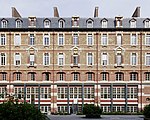The Panthéon (French: [pɑ̃.te.ɔ̃], from the Classical Greek word πάνθειον, pántheion, '[temple] to all the gods') is a monument in the 5th arrondissement of Paris, France. It stands in the Latin Quarter, atop the Montagne Sainte-Geneviève, in the centre of the Place du Panthéon, which was named after it. The edifice was built between 1758 and 1790, from designs by Jacques-Germain Soufflot, at the behest of King Louis XV of France; the king intended it as a church dedicated to Saint Genevieve, Paris' patron saint, whose relics were to be housed in the church. Neither Soufflot nor Louis XV lived to see the church completed.
By the time the construction was finished, the French Revolution had started; the National Constituent Assembly voted in 1791 to transform the Church of Saint Genevieve into a mausoleum for the remains of distinguished French citizens, modelled on the Pantheon in Rome which had been used in this way since the 16th century. The first panthéonisé was Honoré Gabriel Riqueti, comte de Mirabeau, although his remains were removed from the building a few years later. The Panthéon was twice restored to church usage in the course of the 19th century—although Soufflot's remains were transferred inside it in 1829—until the French Third Republic finally decreed the building's exclusive use as a mausoleum in 1881. The placement of Victor Hugo's remains in the crypt in 1885 was its first entombment in over fifty years.
The successive changes in the Panthéon's purpose resulted in modifications of the pedimental sculptures and the capping of the dome by a cross or a flag; some of the originally existing windows were blocked up with masonry in order to give the interior a darker and more funereal atmosphere, which compromised somewhat Soufflot's initial attempt at combining the lightness and brightness of the Gothic cathedral with classical principles. The architecture of the Panthéon is an early example of Neoclassicism, surmounted by a dome that owes some of its character to Bramante's Tempietto.
In 1851, Léon Foucault conducted a demonstration of diurnal motion at the Panthéon by suspending a pendulum from the ceiling, a copy of which is still visible today. As of December 2021 the remains of 81 people (75 men and six women) had been transferred to the Panthéon. More than half of all the panthéonisations were made under Napoleon's rule during the First French Empire.












